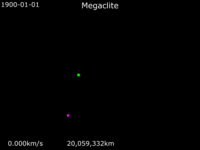Megaclite facts for kids

Megaclite imaged by the Canada-France-Hawaii Telescope in December 2001
|
|
| Discovery | |
|---|---|
| Discovered by | Scott S. Sheppard David C. Jewitt Yanga R. Fernandez Eugene A. Magnier |
| Discovery site | Mauna Kea Observatory |
| Discovery date | 25 November 2000 |
| Designations | |
| MPC designation | Jupiter XIX |
| Pronunciation | /mɛɡəˈklaɪtiː/ |
|
Named after
|
Μεγακλειτή Megaclītē |
| S/2000 J 8 | |
| Adjectives | Megaclitean /ˌmɛɡəklɪˈtiːən/ |
| Orbital characteristics | |
| Epoch 27 April 2019 (JD 2458600.5) | |
| Observation arc | 16.26 yr (5,938 days) |
| 0.1586666 AU (23,736,190 km) | |
| Eccentricity | 0.4102170 |
| –747.09 d | |
| 269.64681° | |
|
Mean motion
|
0° 28m 54.732s / day |
| Inclination | 143.20224° (to ecliptic) |
| 356.52408° | |
| 8.71854° | |
| Satellite of | Jupiter |
| Physical characteristics | |
|
Mean diameter
|
≈ 6 km |
| Albedo | 0.04 (assumed) |
| 21.7 | |
| 15.0 | |
Megaclite (pronounced meh-guh-KLY-tee), also known as Jupiter XIX, is one of the many natural satellites, or moons, that orbit the giant planet Jupiter. It was first spotted by a team of astronomers from the University of Hawaii. This team was led by Scott S. Sheppard in the year 2000. When it was first found, it was given a temporary name: S/2000 J 8.
Contents
Discovering Megaclite
Megaclite was discovered on November 25, 2000. The team of astronomers included Scott S. Sheppard, David C. Jewitt, Yanga R. Fernandez, and Eugene A. Magnier. They found this moon using telescopes at the Mauna Kea Observatory in Hawaii.
Megaclite's Orbit and Size
Megaclite is a small moon, only about 6 kilometers (about 3.7 miles) wide. It travels around Jupiter at a very far distance. On average, it is about 24,687,000 kilometers (about 15.3 million miles) away from Jupiter.
It takes Megaclite about 747 days to complete one full orbit around Jupiter. This is a little over two Earth years. Megaclite's orbit is also unusual because it moves in a "retrograde" direction. This means it orbits Jupiter in the opposite direction to Jupiter's rotation. Its orbit is also quite tilted, at about 150 degrees compared to the ecliptic (the path the Sun appears to take across the sky). The orbit is also not a perfect circle; it is more of an oval shape, which scientists call having an "eccentricity" of 0.308.
Naming Megaclite
After its discovery, Megaclite was given its official name in October 2002. It was named after Megaclite, a figure from Greek mythology. In these ancient stories, Megaclite was said to be the mother of Thebe and Locrus, and her partner was Zeus. Zeus is the Greek god who is similar to the Roman god Jupiter, which is why the moon is named after her.
Megaclite's Family: The Pasiphae Group
Megaclite is part of a group of moons called the Pasiphae group. These are all irregular moons that orbit Jupiter. They are called "irregular" because their orbits are not neat and circular like some of Jupiter's larger moons.
- Moons in the Pasiphae group orbit Jupiter at distances between 22.8 and 24.7 million kilometers.
- Their orbits are also tilted, with inclinations ranging from 144.5 to 158.3 degrees.
- All moons in this group, including Megaclite, have retrograde orbits.
While many moons in this group, like Pasiphae itself, appear gray, Megaclite has a light red color. This makes it look more similar to another moon called Callirrhoe.
See also
 In Spanish: Megaclite (satélite) para niños
In Spanish: Megaclite (satélite) para niños



